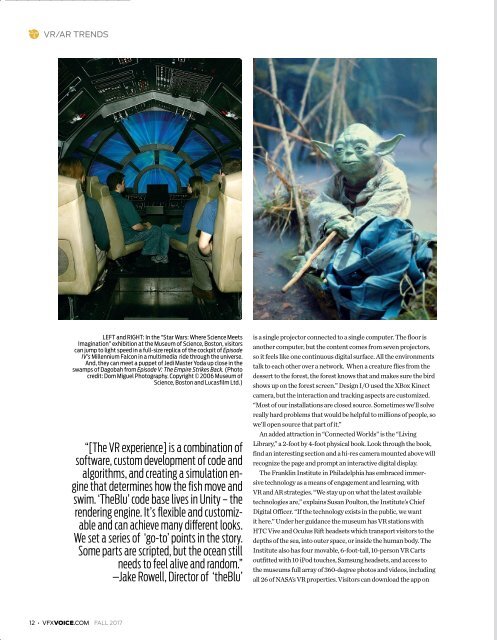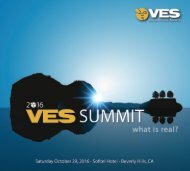Create successful ePaper yourself
Turn your PDF publications into a flip-book with our unique Google optimized e-Paper software.
VR/AR TRENDS<br />
LEFT and RIGHT: In the “Star Wars: Where Science Meets<br />
Imagination” exhibition at the Museum of Science, Boston, visitors<br />
can jump to light speed in a full-size replica of the cockpit of Episode<br />
IV’s Millennium Falcon in a multimedia ride through the universe.<br />
And, they can meet a puppet of Jedi Master Yoda up close in the<br />
swamps of Dagobah from Episode V: The Empire Strikes Back. (Photo<br />
credit: Dom Miguel Photography. Copyright © 2006 Museum of<br />
Science, Boston and Lucasfilm Ltd.)<br />
“[The VR experience] is a combination of<br />
software, custom development of code and<br />
algorithms, and creating a simulation engine<br />
that determines how the fish move and<br />
swim. ‘TheBlu’ code base lives in Unity – the<br />
rendering engine. It’s flexible and customizable<br />
and can achieve many different looks.<br />
We set a series of ‘go-to’ points in the story.<br />
Some parts are scripted, but the ocean still<br />
needs to feel alive and random.”<br />
—Jake Rowell, Director of ‘theBlu’<br />
is a single projector connected to a single computer. The floor is<br />
another computer, but the content comes from seven projectors,<br />
so it feels like one continuous digital surface. All the environments<br />
talk to each other over a network. When a creature flies from the<br />
dessert to the forest, the forest knows that and makes sure the bird<br />
shows up on the forest screen.” Design I/O used the XBox Kinect<br />
camera, but the interaction and tracking aspects are customized.<br />
“Most of our installations are closed source. Sometimes we’ll solve<br />
really hard problems that would be helpful to millions of people, so<br />
we’ll open source that part of it.”<br />
An added attraction in “Connected Worlds” is the “Living<br />
Library,” a 2-foot by 4-foot physical book. Look through the book,<br />
find an interesting section and a hi-res camera mounted above will<br />
recognize the page and prompt an interactive digital display.<br />
The Franklin Institute in Philadelphia has embraced immersive<br />
technology as a means of engagement and learning, with<br />
VR and AR strategies. “We stay up on what the latest available<br />
technologies are,” explains Susan Poulton, the Institute’s Chief<br />
Digital Officer. “If the technology exists in the public, we want<br />
it here.” Under her guidance the museum has VR stations with<br />
HTC Vive and Oculus Rift headsets which transport visitors to the<br />
depths of the sea, into outer space, or inside the human body. The<br />
Institute also has four movable, 6-foot-tall, 10-person VR Carts<br />
outfitted with 10 iPod touches, Samsung headsets, and access to<br />
the museums full array of 360-degree photos and videos, including<br />
all 26 of NASA’s VR properties. Visitors can download the app on<br />
12 • <strong>VFX</strong>VOICE.COM FALL <strong>2017</strong>




